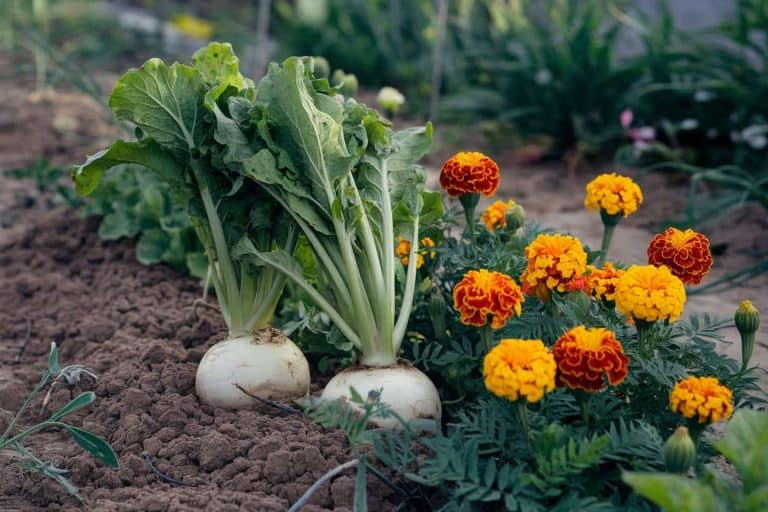You want juicy, vine-ripened tomatoes, not sad plants or a hot mess of pest troubles. I totally get it—I love homegrown tomatoes, too! Let me show you what works and what’s just garden gossip when it comes to the best companion plants for tomatoes.
Companion planting can seriously help with pest control, flavor, and even garden beauty. But it’s not magic. Some combos improve growth and health, while others just sound fancy but do nothing (or even cause problems). If you know the difference, you’ll avoid wasted effort and heartbreak.
Here’s my honest take: companion planting helps keep bugs at bay and soil healthy, and sometimes it really boosts yields. But, if you plant the wrong neighbors, you could make life harder for your tomatoes. So, let’s dig into what works.

What Makes a Great Companion for Tomatoes?
A “companion plant” for tomatoes is just a plant that plays nice with them, either by helping them out or at least not bothering them. It could be herbs, flowers, other vegetables, or cover crops.
The goal? Fewer pests, better pollination, improved soil, and less work for you, with a little bit of bonus beauty along the way.
Main benefits of the best tomato companion plants:
- Repel pests naturally.
- Boost flavor or vigor.
- Attract pollinators.
- Shade the soil, lock in moisture, and cut down weeding.
- Improve soil by adding nutrients or breaking up tough ground.
Climate and tomato variety do affect results, though. In super-hot, dry summers, companions that act as “living mulch” (like lettuce or wheat around the base) can really make a difference.
I learned the hard way that some plants burn up in midsummer, so spacing and timing matter more than just “does this plant like tomatoes.”
The best companion plants for tomatoes don't compete for nutrients or root space, don't attract the same insects as tomato plants do, and help to repel pests.
All-Star List: Best Companion Plants for Tomatoes
Let’s divide these up by category, so you can build your tomato bed like a seasoned homesteader (even if you’re just getting started).
Herb Heroes
Some herbs are tomatoes’ best friends. They help ward off bugs, bring in pollinators, and even make your garden smell amazing. Here’s how these “herb heroes” can help your tomato patch thrive.
Basil: The MVP of tomato partners. Not only does basil repel flies and hornworms, but it can also improve tomato flavor. The internet goes wild over “basil makes tomatoes sweeter!” Truth: your soil, water, and sunshine matter more, but I do feel tomatoes are happier with basil nearby. Don’t smother your plants though—give everyone space.

Parsley attracts helpful insects like hoverflies, which eat aphids and other pests. Tuck parsley along the outer edge of your tomato bed so it gets sun without blocking your tomatoes.
Dill brings in bees and ladybugs when young, making it a great early-season partner. Just harvest dill before it gets too tall, because mature plants can slow your tomatoes’ growth.
Thyme is easy to grow along the borders. It helps keep away bugs, and compact varieties are perfect for filling small gaps.
Rosemary is tough and drought-resistant. Its woody stems can live near tomatoes, just not too close. Rosemary’s scent can confuse harmful insects searching for tomatoes.
Borage is a magnet for pollinators and helps keep hornworms off your tomatoes. The blue flowers are edible, too. Borage plants get big, so one or two per bed is plenty.
Mixing these herbs into your tomato garden does more than just repel pests. You’ll get more pollinators, better soil, and a good harvest with less fuss. If you want extra ideas, check out The Spruce's guide to tomato companions.
Flower Sidekicks
Adding the right flowers to your tomato patch does more than just make the garden look good. Certain blooms actually protect tomatoes from pests, attract pollinators, and help you grow stronger plants.
Marigolds are a solid pick for any tomato grower. These bright flowers help control nematodes in the soil and fend off pests like aphids and whiteflies. I plant marigolds near every tomato every season, and hornworms almost always leave those tomatoes alone. Their scent is strong enough to confuse pests, making them a top choice for natural protection.
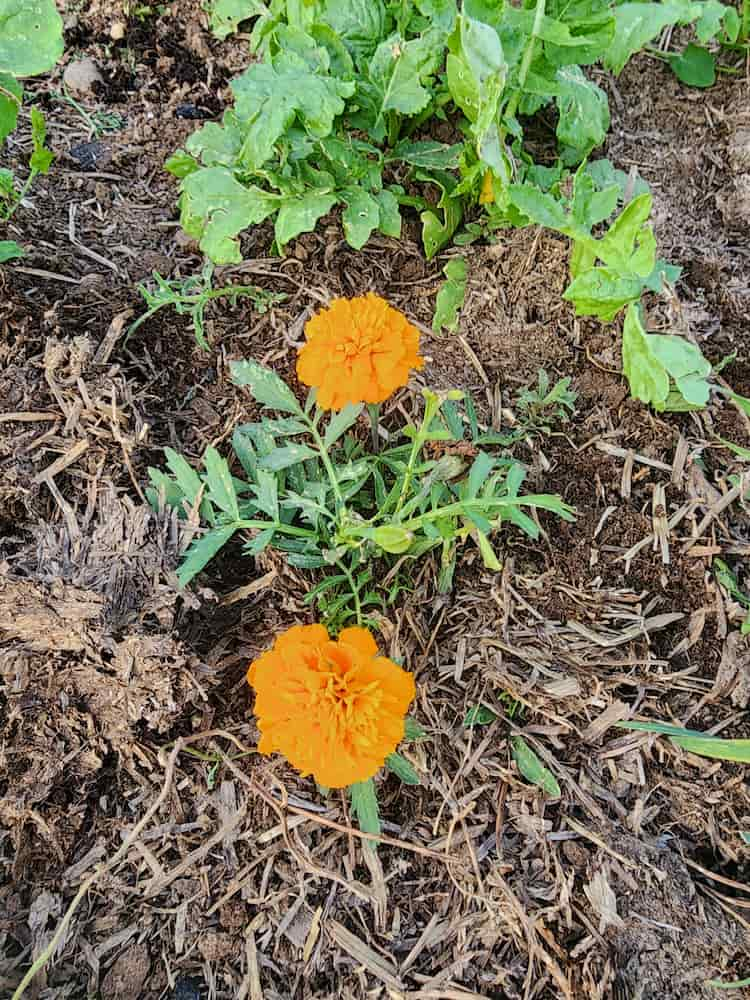
Nasturtiums do double duty. Their flowers are pretty and edible, but the real bonus is how they act as a trap crop. Aphids, whiteflies, and beetles prefer nasturtiums over tomatoes, so planting them along bed edges keeps your main crop safer. They spread out easily, covering bare soil and crowding out weeds without taking over.
If you want to bring more pollinators, add a few calendulas or sweet alyssum around your tomatoes. These flowers bloom for a long time and draw bees and hoverflies. More pollinators mean more fruit set and a healthier harvest.
Choose flowers that fit the space you have. For small gardens, stick with compact varieties or plant them in containers alongside tomatoes. These flower sidekicks don’t just add color—they help your tomato plants thrive with very little extra effort.
Veggie Teammates
Veggie teammates can fill empty garden spots while helping tomatoes stay healthier. Mixing in these plants gives you more harvest and better soil, with little fuss.
Go for quick-growing crops like radishes and leafy greens early in the season. Later, let bush beans do their thing in the gaps. This keeps weeds down and your tomato patch diverse, so you get fewer problems and more to eat all summer.
Carrots: Tomatoes and carrots are friends—carrots help open up the soil, and tomatoes offer shade. Carrots might grow a little wonky, but that’s no big deal; soon they’ll be reaching for the sun and filling your kitchen with flavor.
Leafy Greens: These are classic “living mulches.” Plant them at the feet of tomatoes early in the season to shade roots and keep moisture locked in. They also improve the soil by adding organic matter when they decompose.
Want to see what else you can grow? Check out companion plants for spinach for even more garden pairings.
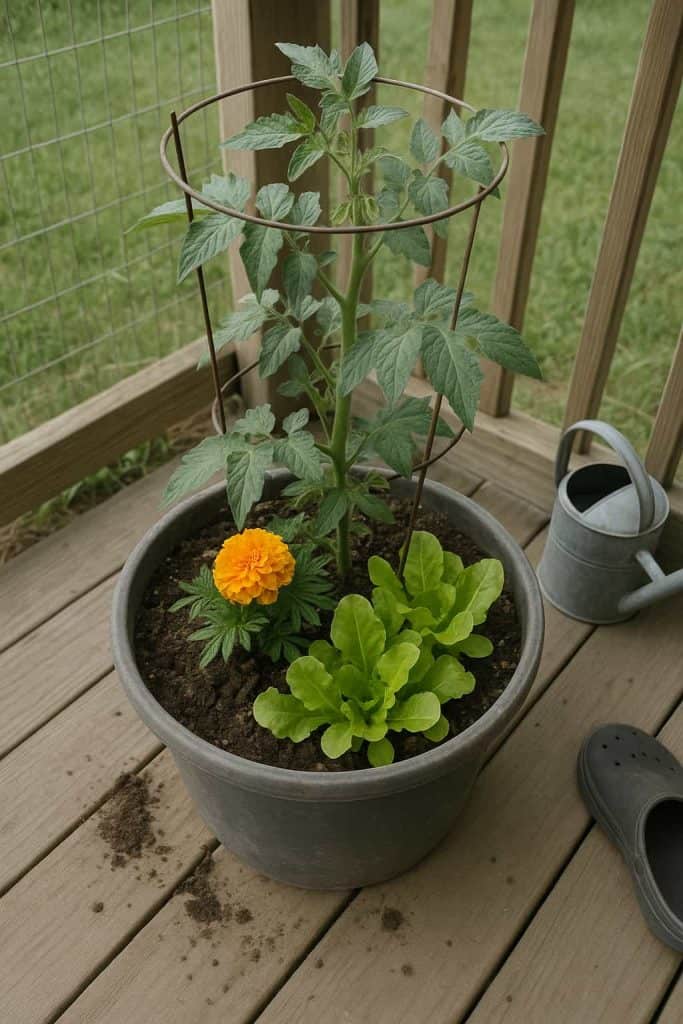
Bush Beans: These fix nitrogen in the soil for next year's plants. Tomatoes are heavy feeders, so beans help replace the nutrients they use to grow.
Avoid pole beans, though; they'll get tangled up in your tomato plants and can do more harm than good. (Plus, can you imagine trying to find green beans on green vines in a green tomato jungle? lol)
Asparagus: Once established, asparagus and tomatoes can help each other fight off nematodes. Not an instant fix, but worth considering for long-term gardens. Plus, the asparagus season is usually over by the time your tomatoes are starting to grow.
Alliums (Onion, Garlic, Chives): Their pungent scent confuses pests and adds another bonus for pest control. There is even a study done showing alliums form a scent barrier that deters rabbits from crossing into your tomatoes!
If you grow onions with your tomatoes, you can pair them up in this great red chilaquiles recipe from Sylvia over at Mama Latina Tips! (Her recipes are ah-maze-ing!)
Radishes: Quick to grow, radishes can act as a trap crop for flea beetles, and their shallow roots utilize a different growing space than the deeper tomato roots.
Companions for Weed Control
Cover crops like winter rye, crimson clover, hairy vetch, wheat, and oats serve as living mulch. They keep weeds down, fix nitrogen (legumes like vetch and clover), and boost organic matter when turned into the soil.
They also help prevent soil from splashing onto your tomato plants, which can cut down on disease spread. If you’re trying to build healthy soil or cut back on weeding, these are your friends.
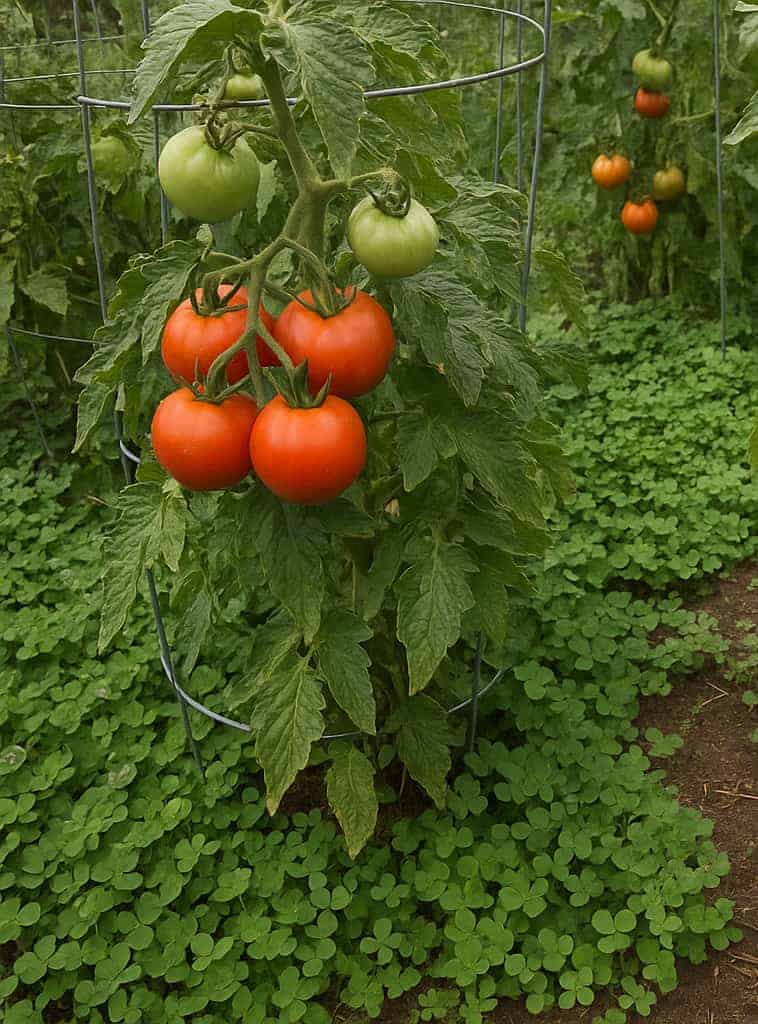
Bonus: Pollinator Attractors
Calendula and Sweet Alyssum: Quick-growing and bee-friendly, these two slot easily into gaps and flower all summer. Alyssum sprawls and fills in, calendula brings cheery color.
(Bonus, calendula petals are very useful in skin remedies!)
Sunflowers: Grow these on the edge of your tomato beds for bee support, but keep in mind—they can outcompete tomatoes for nutrients and even slow growth through “allelopathy” (releasing chemicals that bother other plants), so don’t get carried away.
Red Clover: This one’s a multitasker—great for bumble bee support and fits in as a living mulch. Clip it before it goes to seed to keep things tidy.
What NOT to Plant with Tomatoes: Troublemakers to Avoid
Some plants look nice on paper but make rotten neighbors. Trust me, it’s just not worth it.
Brassicas (Broccoli, Cabbage, Kale): They hog nutrients and crowd roots. Nobody’s happy.
Corn: Corn and tomatoes attract the same pests, especially the tomato fruitworm. That’s extra work and more bugs.
Potatoes & Eggplant: These cousins of tomatoes share diseases (like blight). Grow them in separate beds to dodge disaster.
Fennel: Fennel stunts tomato growth and almost everything else it touches. It's best to give it plenty of space to grow away from other plants.
Avoiding these troublemakers will save you stress and disappointment later on. Stick with proven companions and keep these problem plants far away for a smoother, more productive season.
Grab our Free Seed Starting Succes Guide!
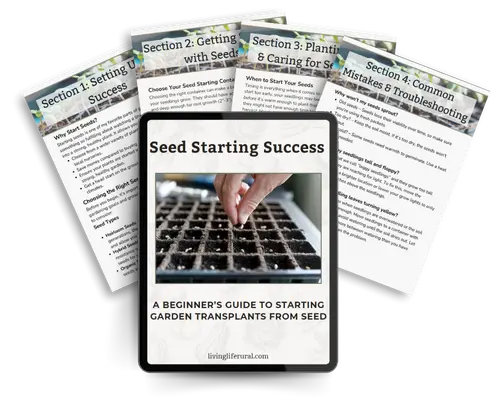
How to Plan and Plant Your Tomato Companion Bed
Don’t overthink it. Here’s the breakdown for beginners:
- Start your tomato seedlings (early spring indoors or buy starts). Harden them off outside.
- Layout: Give each tomato plant at least 18-24 inches of space. Think air flow first, pretty combos second. I know it looks like a ton of space between each plant or row, but it won't come August, lol.
- Companion spots: Slot basil and parsley on the sunny sides, lettuce and spinach under the leaf canopy, and marigolds and nasturtium at the bed edge.
- Weed control: If using wheat, oats, or clover, scatter seed gently between tomato plants once the danger of frost passes.
- Water at the base, not the leaves (to avoid mildew). Drip is by far best, but a slow, deep soak works. If you live in a dry area, you can get away with watering overhead if you do it overnight or early in the morning.
- Mulch with straw, grass clippings, or compost to keep moisture in if you're not using a living mulch. (wood chips and straw are my favorite two options.)
I like to trench my tomatoes (digging a shallow trench and laying them sideways, then turning up the tp), but even if your tomatoes go in upright be sure they are planted deep with plenty of space between. (space for tomatoes is really important if you haven't noticed, lol)
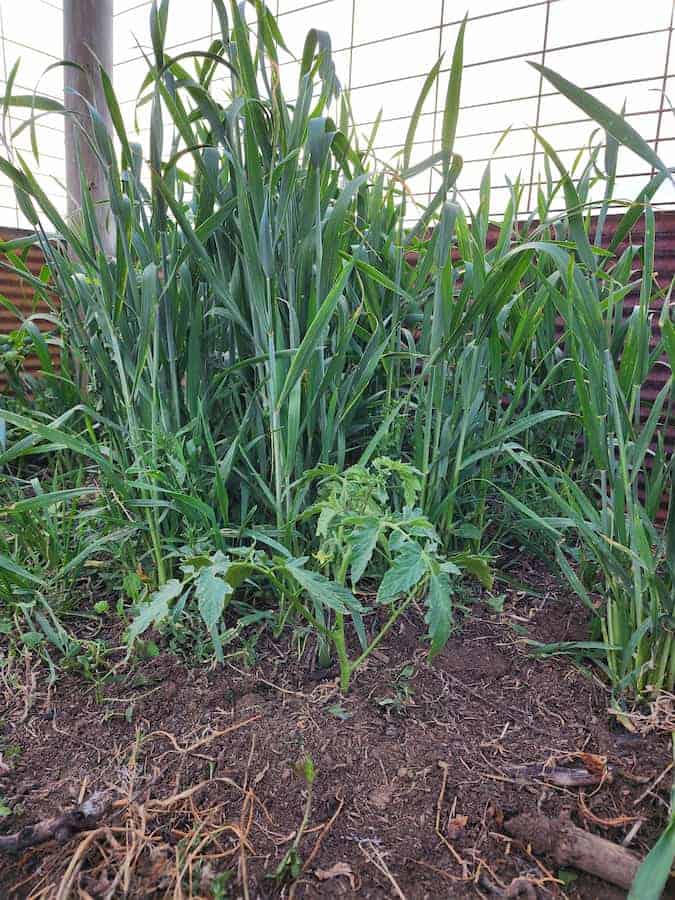
Real-Life Results
A couple of summers ago, it was hot, dry, and absolutely BRUTAL. I’d pretty much given up on my tomato plants But then, some wheat sprouted around it (no, I didn’t plant it—it came from the wheat straw I had used for mulch). Wildly, that was the only tomato that actually bounced back and gave me any fruit when all the others pooped out.
I’m trying “living mulch” again this year with an actual plan. I’ll update this post as soon as I have results (because hey, everyone starts somewhere, even repeat offenders like me, lol).
And yes, I always plant marigolds with my tomatoes. They seriously help keep hornworms gone in my beds. I know it sounds cliche, but honestly, it’s my 100% go-to trick. Robin at Sow Many Plants has a great guide on naturally controlling tomato hornworms if you need more help with those pesky pests!
FAQ's
Success Starts with the Right Neighbors
Everybody wants those show-off tomato vines that overflow with fruit. Here’s my biggest takeaway: less is more. Don’t crowd your companion plants, water early in the morning, late in the evening, or overnight (if you live in a hot, dry area), and mulch like a pro. The right companions truly make tomatoes easier, tastier, and a whole lot prettier. Not fancy, just functional.
If you need more tips, take a look at companion plants for spinach for ideas that work for other crops, too. And if you're looking to up your tomato game, here's a guide for growing indeterminate tomatoes that's beginner-friendly, promise.
No shame in asking questions—everyone starts somewhere! Whether you’re a hot mess express in the garden (like me most days) or just want a prettier, healthier tomato bed, these combos really work if you give them a shot. Happy planting!



